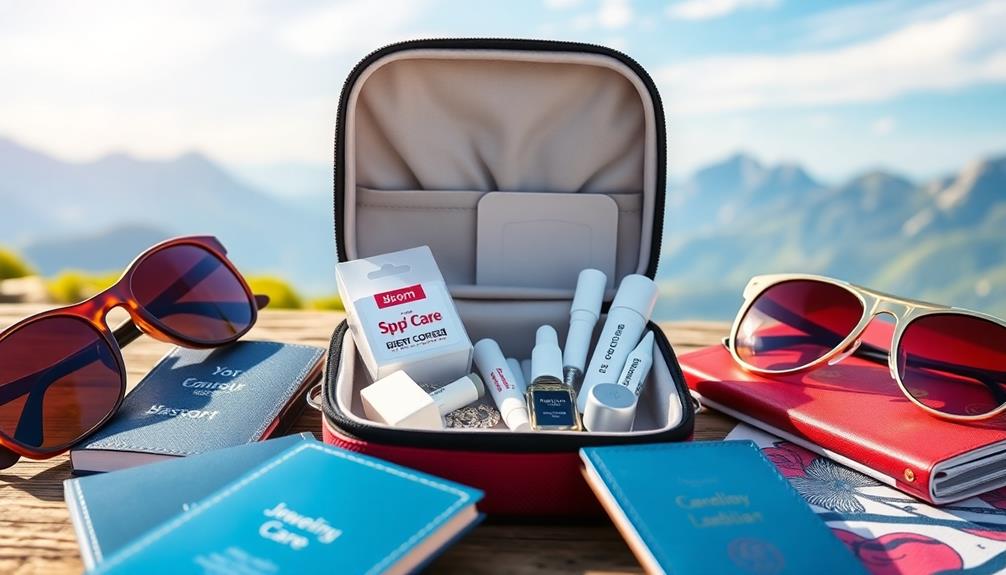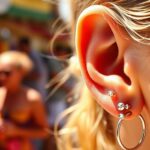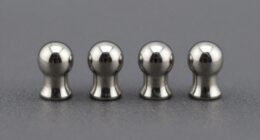Caring for your piercings while traveling requires extra attention. Start by washing your hands thoroughly before touching your piercings. Pack essential aftercare supplies, like saline solution and gauze, for easy access. Clean your piercings with saline two to three times daily, especially in crowded places like airports. Stay hydrated to help with healing and manage discomfort from pressure changes during flights. Avoid touching your piercings with dirty hands and sanitize surfaces when possible. By taking these steps, you can minimize infection risks and guarantee your piercings stay healthy. Discover more tips to make your travel experience smoother.
Key Takeaways
- Consult a professional piercer for personalized travel advice and schedule flights after the initial healing period of 6-8 weeks.
- Pack essential aftercare supplies like saline solution and sterile gauze to clean piercings 2-3 times daily.
- Maintain hygiene by washing hands thoroughly before touching piercings and using disposable paper towels.
- Stay hydrated to support healing and mitigate discomfort from pressure changes during air travel.
- Monitor for signs of infection and clean piercings regularly, especially in crowded environments like airports.
Effects of Travel on Piercings
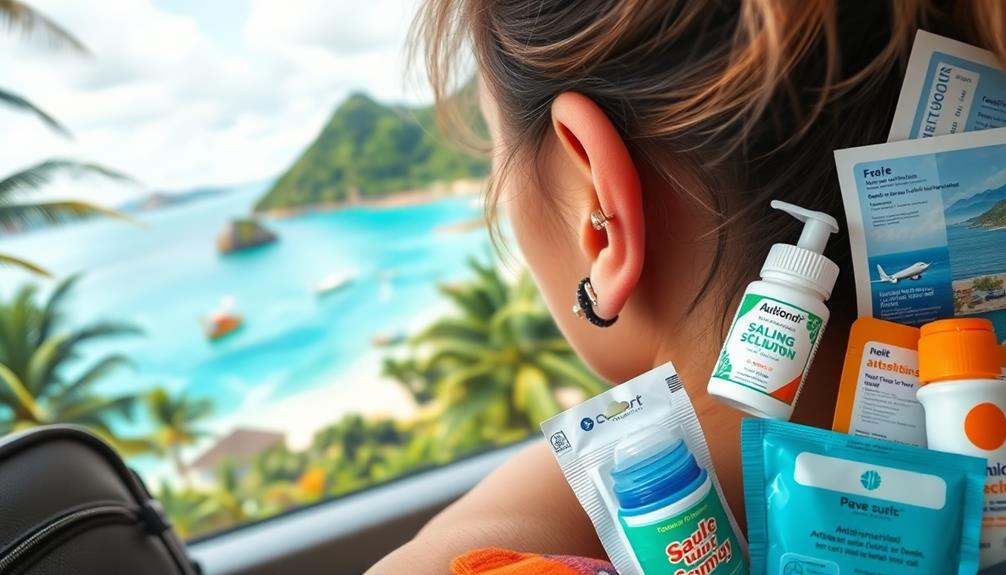
When traveling, especially by air, fresh piercings can be particularly vulnerable to discomfort. The rapid pressure changes during takeoff and landing can cause temporary swelling around the piercing site, which might hinder the healing period.
It's essential to stay aware of this, as discomfort can escalate if you don't take proper precautions.
Hydration plays a significant role in piercing aftercare. Dehydration can adversely affect your body's ability to heal, so make certain you're drinking plenty of water before, during, and after your flight.
In crowded environments like airports, the risk of infection increases due to bacteria, making strict hygiene practices indispensable. Always clean your hands thoroughly before touching your piercing and consider disinfecting your jewelry regularly.
Environmental factors, such as dust and climate changes, can also exacerbate irritation or infection risks. When traveling with a new piercing, be extra cautious.
Avoid touching the area unnecessarily, and consider using a travel-friendly piercing care kit to keep everything sanitized. By staying vigilant and maintaining proper care, you can help guarantee your piercing heals well, even amidst the challenges of travel.
Pre-Travel Preparation Tips

Traveling with a new piercing requires thoughtful preparation to guarantee it heals properly. Start by consulting with a professional piercer to assess your piercing's healing stage and get personalized travel advice.
Ideally, schedule your flights after the initial healing period of 6-8 weeks to reduce discomfort from cabin pressure changes.
Consider the climate of your destination, as humidity and temperature can impact the healing process. This leads to the significance of packing appropriate aftercare supplies.
Create a detailed list of aftercare practices, including sterile saline solutions and sterile gauze, essential for cleaning your piercing during your trip.
Always choose reputable piercers at your destination in case you need assistance or a check-up. Having trustworthy options guarantees consistent hygiene standards and care.
Remember, a healthy immune system is crucial for your body's ability to heal, so prioritize rest and proper nutrition while traveling.
Hygiene Maintenance While Traveling
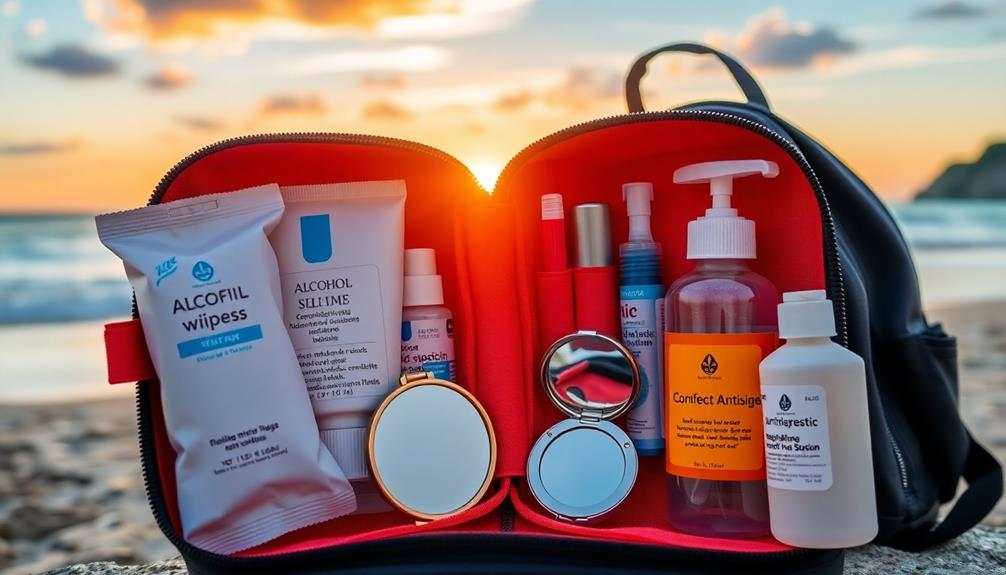
Maintaining hygiene during your travels is essential for the health of your piercings. Always wash your hands thoroughly before handling your piercings, especially in public spaces, to minimize the risk of infection.
A key part of your daily routine should include carrying a sterile saline solution to clean your piercings 2-3 times daily. This guarantees you maintain hygiene even while on the go.
Make it a point to avoid touching your piercing with unwashed hands. Instead, use disposable paper towels for drying, as cloths may harbor bacteria. Sanitize surfaces and seating areas in public transport and accommodations before making contact. This simple step can notably reduce your exposure to germs.
Consider using travel-sized aftercare products for convenience, making it easier to stick to your hygiene maintenance plan. Always pack enough supplies for the duration of your trip.
If you need to touch your piercing, confirm you're wearing a clean t-shirt over your hands, or use a clean paper towel as a barrier. By following these guidelines, you'll help keep your piercing healthy and infection-free while enjoying your travels.
Managing Discomfort and Complications

Although you might be excited about your journey, discomfort and complications from piercings can arise, especially during flights. Rapid changes in air pressure can cause pain or sensitivity in fresh piercings, particularly during takeoff and landing. If you notice swelling, it may hinder the healing process, so keep an eye out for any signs of infection.
To help manage discomfort, gently move your jaw or swallow to equalize ear pressure. Staying hydrated is essential, as dehydration can exacerbate discomfort. Here's a quick reference table to help you identify and manage potential issues:
| Signs of Infection | Care Tips |
|---|---|
| Unusual redness | Use saline solution to rinse |
| Persistent pain | Keep the area clean |
| Discharge | Avoid touching the piercing |
| Swelling | Stay hydrated |
Essential Aftercare Tools and Practices

How can you guarantee your piercings stay healthy while on the go? Start by packing essential aftercare tools. Make sure you have enough saline solution and sterile gauze to clean your piercings properly throughout your travels.
Clean your piercing site at least twice daily with saline solution, using disposable paper towels instead of cloth ones to prevent introducing bacteria. A travel-sized aftercare spray, like NeilMed, is a great addition for convenient cleaning access, especially in public restrooms.
Before you handle your piercings, wash your hands thoroughly to reduce the risk of infection and complications. Always prioritize hygiene—your hands should be clean before touching any part of your piercing.
When it comes to rinsing, opt for bottled water instead of tap water to avoid potential contaminants, particularly in unfamiliar locations. This extra precaution can go a long way in ensuring your piercings remain healthy and free of irritation.
Frequently Asked Questions
How to Clean Piercings on Vacation?
To clean your piercings on vacation, use a sterile saline solution twice daily. If unavailable, mix non-iodized sea salt with distilled water. Always wash your hands first, and pat dry with sterile gauze or paper towels.
Can You Travel With Piercings?
Yes, you can travel with piercings, but it's best to wait until they're fully healed. Keep them clean, stay hydrated, and avoid touching them in public to minimize discomfort and prevent infections.
Do Piercings Swell on a Plane?
Yes, piercings can swell on a plane due to rapid cabin pressure changes during takeoff and landing. You might experience discomfort, so it's best to fly after the initial healing period of 6-8 weeks.
Can You Go on Rides With a New Piercing?
You shouldn't go on rides with a new piercing. Intense motion can irritate or damage it, especially in the first 6-8 weeks. Stick to gentler attractions to protect your piercing while it heals.
Conclusion
In the grand journey of life, your piercings are like delicate flowers—beautiful but needing care and attention. Just as you wouldn't let a flower wilt on a trip, don't neglect your piercings while traveling. With a little preparation and some essential aftercare tools, you can keep them thriving, no matter where your adventures take you. So, pack your hygiene essentials, stay mindful, and enjoy every moment without worrying about your piercings. Safe travels!

